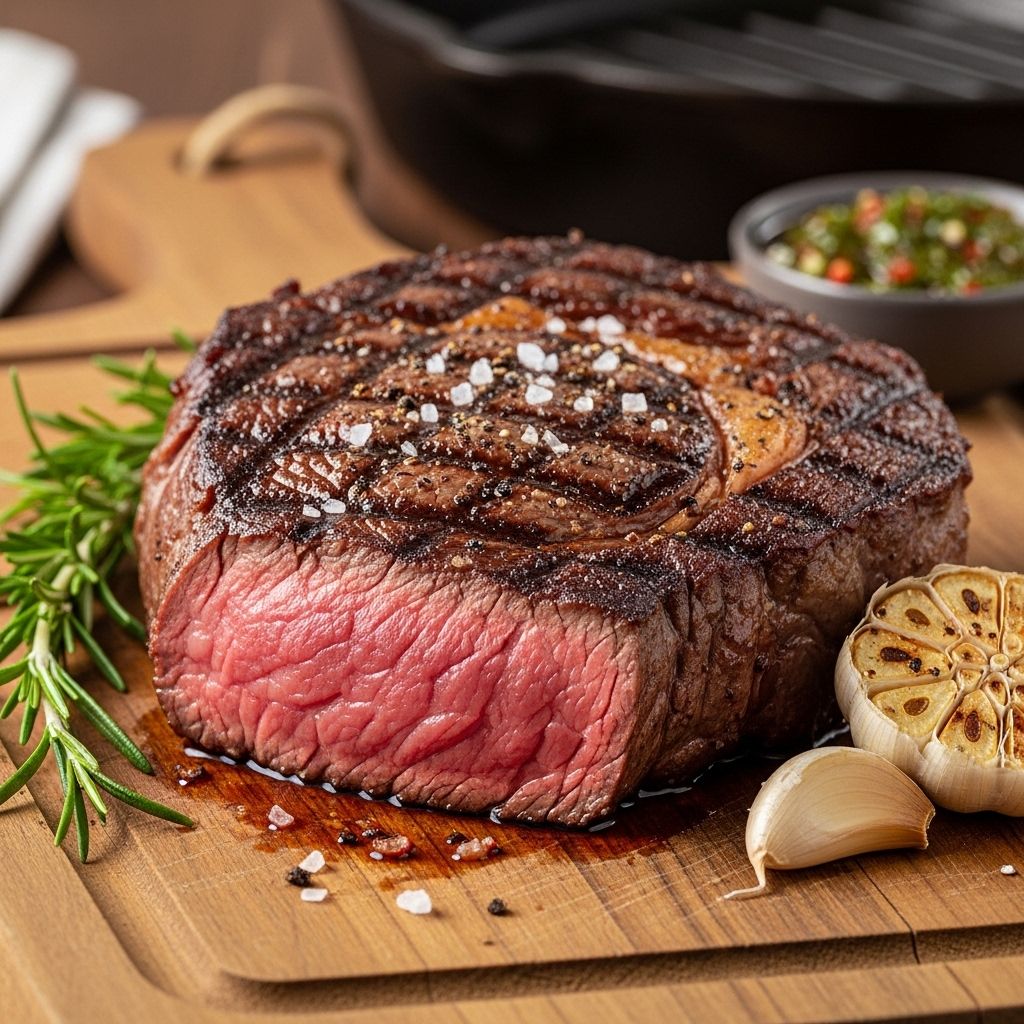Meet the Ribeye Cap: The Tastiest Cut on the Cow
This elusive steak showcases an open grain that locks in juices for a memorable bite.

If you’re on a quest for the world’s most flavorful and tender steak, look no further than the ribeye cap. Known among butchers and culinary insiders as the spinalis dorsi, this extraordinary beef cut sits atop the ribeye, boasting unrivaled richness, tenderness, and a depth of marbled flavor that has earned it cult status among chefs and steak enthusiasts.
What Exactly Is the Ribeye Cap?
The ribeye cap is the outermost muscle on a prime rib roast, forming a crescent-shaped band encircling the eye of the ribeye. Butchers call it the spinalis dorsi. When the rib roast is cut into ribeye steaks, the cap remains along the edge, distinguished by its loose texture, deep marbling, and eye-catching appearance. When the cap is trimmed away and prepared on its own, you unlock a beef-eating experience that many chefs single out as the single best cut on the cow.
- Alternate names: Spinalis dorsi, deckle, rib cap
- Location: Outermost layer of the rib primal, directly above the ribeye eye muscle
- Traits: Abundant marbling, loose grain, fork-tender texture, and profound beefy flavor
Why Is the Ribeye Cap So Prized?
The ribeye cap’s acclaim stems from the interplay between its intricate fat marbling and its unique, almost spongy, soft muscle. The result is a cut that remains juicy after cooking, develops a deeply browned, flavorful crust, and melts sumptuously with each bite.
Its signature qualities include:
- Intense marbling that bastes the meat internally
- Loose, open texture that soaks up flavors and heat
- Complex beef flavor that some describe as richer than even the ribeye’s core
- Supreme tenderness—rivaling filet mignon but with far more taste
Ribeye Cap vs. Other Cuts: A Flavor and Texture Comparison
| Cut | Flavor Intensity | Tenderness | Marbling | Common Use |
|---|---|---|---|---|
| Ribeye Cap (Spinalis dorsi) | Very High | Very Tender | Extensive | Grilling, Searing, Roasting |
| Ribeye Steak | High | Tender | High | Grilling, Pan-Searing |
| Filet Mignon | Moderate | Very Tender | Low | Pan-Searing, Grilling |
| New York Strip | Moderate-High | Moderate | Moderate | Grilling, Broiling |
How to Identify the Ribeye Cap
This elusive cut typically appears in two main forms at butchers and specialty purveyors:
- Flats: When the cap is separated off a rib roast and left whole. In this form, it looks like a long, thin sheet with waves of loosely bundled muscle and visible marbling streaks.
- Pinwheels: Common in upscale butcher shops, the cap is rolled tightly from end to end and tied with butcher’s twine, then sliced crosswise into thick, round “pinwheel” steaks. These pinwheels echo the classic steakhouse look but with the unique structure and flavor of the cap.
Both forms deliver exceptional eating quality, but their presentation and ideal cooking methods vary.
The Pursuit for Ribeye Cap: Availability and Rarity
Among all beef cuts, ribeye cap stands out as one of the rarer finds. There is only a small amount of this muscle on each steer. As a result, most cap ends up as part of whole ribeye steaks or roasts, rarely separated out for individual sale. If you encounter standalone ribeye cap in a butcher’s case, consider it an opportunity not to be missed.
- Some restaurant menus—and especially Michelin-starred steakhouses—feature ribeye cap as a luxurious specialty.
- Online specialty meat purveyors occasionally offer ribeye cap steaks, most often from Wagyu or high-grade USDA beef.
- For adventurous home cooks, ask your butcher if they can custom-cut the ribeye cap for you. It may require a special order.
Is Ribeye Cap Worth the Price?
Given its scarcity and unparalleled eating experience, ribeye cap frequently commands a premium price—often rivaling or exceeding that of well-known steaks like filet mignon or whole ribeye.
For devoted beef connoisseurs, the cap’s flavor and texture are considered well-worth the investment.
The Science of Steak: Why Ribeye Cap Tastes So Good
The unique texture and flavor of the ribeye cap stem from its anatomical position and muscle structure:
- Location: The cap sits at the edge of the rib primal, working less than other muscles, which yields greater tenderness.
- Fat Content: Extensive marbling, with a delicate distribution of intramuscular fat, enhances flavor and helps retain moisture during cooking.
- Loose grain structure: The muscle fibers run at an angle, creating a distinctive wavy texture that soaks up seasoning and sears beautifully.
Cooking the Ribeye Cap: Step-by-Step Success
Cooking ribeye cap is about letting its natural flavor shine through careful but simple preparation:
Recommended Cooking Methods
- Grilling: The high direct heat of a grill highlights the cap’s fat and builds a rich outer crust.
- Searing in a Pan: A cast iron skillet delivers an equally delicious sear, forming a golden crust while enclosing juices.
- Reverse Sear: For thicker or pinwheel steaks, a gentle ‘low and slow’ approach followed by a final high-heat sear prevents overcooking and maximizes tenderness.
Internal Temperatures
For optimal flavor and texture, aim for the following internal temperatures:
- Rare: 120–125°F (49–52°C)
- Medium Rare: 130–135°F (54–57°C)
- Medium: 140–145°F (60–63°C)
Thanks to its copious marbling, ribeye cap savorously withstands a slightly higher degree of doneness than leaner steaks.
Step-by-Step Ribeye Cap Cooking Guide
- Let steaks rest at room temperature for 30 minutes before cooking.
- Pat dry with paper towels to ensure a solid sear.
- Generously season all sides with kosher salt and coarse black pepper.
- Preheat your grill or skillet to high heat. For reverse sear, start low (275–300°F / 135–150°C), finish with maximum heat.
- Cook until the internal temperature is about 5°F below your final target. Let rest 5–10 minutes off the heat before slicing.
- Slice against the grain and enjoy immediately.
Chef Tips for Ribeye Cap Perfection
- Because of its richness, keep sides simple (grilled vegetables, potatoes, light salads).
- For pinwheels, secure the roll with butcher’s twine before grilling or pan-searing.
- The cap’s loose structure will shrink and curl as it cooks—don’t worry, this is normal and concentrates its flavor.
- Avoid overpowering sauces; let the beefy character shine through.
Where to Buy Ribeye Cap Steak
Because of its rarity, ribeye cap is most often found at specialty butchers, upscale grocers, or through online purveyors. When buying, look for:
- Prime or Wagyu Grade: The higher the marbling score, the better the eating experience.
- Even, thick marbling: White flecks should run evenly throughout the entire cut.
- No grayish edges: Fresh ribeye cap will have a deep crimson color with bright white fat.
Online retailers specializing in American Wagyu or high-quality beef often offer 6–8 oz portions, vacuum-sealed for maximum freshness and flavor retention.
Culinary Applications: Beyond a Standalone Steak
Though best appreciated on its own, a cooked ribeye cap elevates many dishes:
- Sandwiches: Thinly sliced and piled high, dripping with juices.
- Toppings for luxury salads: Paired with peppery greens and light vinaigrette.
- Garnishing decadent sides: Sliced onto roasted potatoes or grilled mushrooms.
- Pinwheels can be stuffed before cooking—think fine herbs, truffle butter, or blue cheese crumble.
Nutrition and Health Considerations
As a beef cut from the rib primal, the ribeye cap is rich and indulgent, containing higher levels of fat than lean cuts. However, its abundant marbling is primarily monounsaturated fat, contributing both to mouthfeel and flavor. When enjoyed in moderation as part of a balanced diet, ribeye cap is a source of essential protein, iron, zinc, and B vitamins. If you’re managing your fat intake, savor it as an occasional luxury.
Frequently Asked Questions (FAQs)
Q: What is the ribeye cap steak also called?
A: Ribeye cap steak is often called the spinalis dorsi or simply rib cap. In some butcher circles, it’s referred to as the deckle.
Q: Why is the ribeye cap considered the tastiest part of the cow?
A: Its abundant marbling, tender grain, and deep beef flavor give it a luxurious mouthfeel and an intense, savory profile unmatched by any other cut.
Q: Is ribeye cap hard to find?
A: Yes, it is rare—there’s only a small amount per steer, and it’s frequently left attached to whole ribeyes or prime ribs. Specialty butchers and some high-end online retailers are your best bets.
Q: Can the ribeye cap be overcooked?
A: Its fat content offers protection, but it’s at its juiciest when cooked to medium rare. Overcooking can dry out even this most forgiving steak, so precise temperature control and resting are key.
Q: How does the ribeye cap compare in price and value to other cuts?
A: Expect to pay a premium—often more per pound than filet or strip steak—due to its rarity and highly-prized attributes, but its exceptional flavor makes it a worthwhile treat for special occasions.
In Summary
The ribeye cap stands unmatched for those in search of the richest, most memorable steak experience. If you’re fortunate enough to source it, treat it with respect—and prepare to discover the cut that steakhouses, chefs, and meat aficionados reserve for themselves.
References
- https://blog.thermoworks.com/ribeye-cap-the-best-of-the-best-cooked-just-right/
- https://snakeriverfarms.com/products/cap-of-ribeye-steak
- https://www.kansascitysteaks.com/product/ribeye-cap-steak?bvstate=pg%3A4%2Fct%3Ar
- https://www.fogocharcoal.com/blogs/cook/meet-the-ribeye-cap-steak-the-tastiest-cut-on-the-cow-aka-spinalis-dorsi-over-fogo-lump-charcoal
- https://www.beefitswhatsfordinner.com/cuts/cut/2855/ribeye-cap-steak
Read full bio of Anjali Sayee












